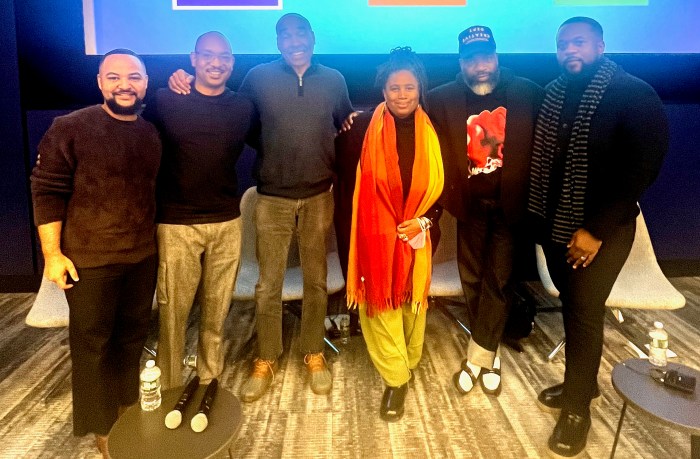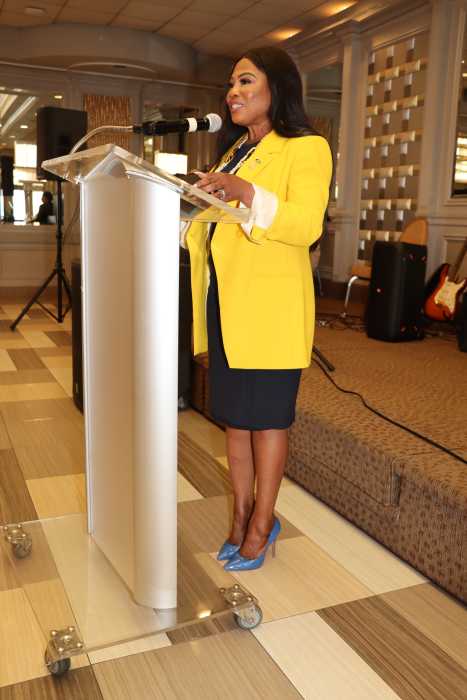Kathleen Kucka’s abstract discourse engages viewers in forging meanings
As New York’s dramatic summer of hurricanes, earthquakes, and torrential downpours gives way to autumn, Kathleen Kucka offers an inventive take on abstract painting. With a stylistic mixture of editorial precision and gestural spontaneity, she reminds us that mankind is forever tethered to nature regardless of our advances in technology.
While her technique –– namely, the pouring of acrylic paint on linen –– is traditional within the genre, the Manhattan-based Kucka still succeeds in offering a new twist in a show that stands out in a crowded field as the season launches in earnest.
In contrast to Helen Frankenthaler or the lesser-known Friedel Dzubas, for example, who both employed a similar process, Kucka does not aim for large color fields. Though her biomorphic forms are just as fluid and free of any geometric overtones, they are much more detailed.
In fact, the largest among her compositions can be quite compartmentalized. They are characterized by a striking array of shapes within shapes that evoke complex cell structures, membranes, and amoebas.
Despite the wealth of visual information, Kucka strives for clarity. Her palette in this new body of work is restrained, consisting of black, white, red, and occasionally blue. If viewed from afar, this makes for a graphic quality, which upon closer inspection is replaced by a sense of painterliness. There simply is no linear construction.
It soon becomes apparent that Kucka’s visuals shift according to the viewer’s perspective and distance from the work. As our perception of them wavers, we wonder if we are observing a micro- or a macrocosm. Is Kucka providing a glimpse of something interior or exterior? Is the abstract landscape before us a reflection of organic or human matter or the illustration of something as ethereal as thought?
As she allows us to project our imagination on the nonrepresentational planes before us, Kucka stands in harmony with the tradition of abstract painting. She wants her audience to be liberated from any preconceived ideas. We are to approach these works freely as they allow us to either find or lose ourselves in them.
In that sense, the question of what there is to find depends on the individual. The rhythmic patterns in “Best Red” and “The Missing Link,” for example, might to some bring the skins of ancient reptiles to mind. To others, it can translate as an almost surreal alignment of dozens of miniscule eyes, which stare at us with as much curiosity as we offer in return. Rendered in vibrant shades of red, “Float or Sink” is as striking and obscure as an alien sonogram.
Despite their highly associative quality, however, Kucka’s paintings can also be read simply as sophisticated compositions that explore concepts of balance by means of color and form. It is the artist’s strength that she allows for a multi-faceted viewing experience.
“Kucka’s work suggests that to find an answer is not a necessity,” writes Stephanie Buhmann in the exhibition catalogue, pointing to the fact that, to the artist, mystery and the preservation of unlimited possibilities remain major ingredients.
This interpretive multiplicity is evident in “Ultra Structures,” an ambitious installation of hubcaps. They are lined up in a grid of 16, which strikingly contrasts with the circular shape of each element. The hubcaps are abstracted by multiple layers of wax and individual backlights that provide a mysterious glow.
Here, Kucka has taken everyday items and turned them into objects of desire. Hubcaps are taken for granted as they roll by us by the millions worldwide. We rarely stop to study the shiny nucleus of the wheel that shuttles a majority of the planet’s population from point A to B. By changing their context, Kucka recognizes their ornamental potential. By eliminating their strictly industrial appearance, she enriches them with an air of mysterious obscurity. It is the beginning of a compelling, albeit strictly abstract discourse into the struggles among man, machine, nature, and the power of our imagination.
KATHLEEN KUCKA
“Ultra Structures”
Brenda Taylor Gallery
505 W. 28th St.
Through Oct. 22
Tue.-Sat., 11 a.m.-5 p.m.
And by appointment at 212-463-7166


























